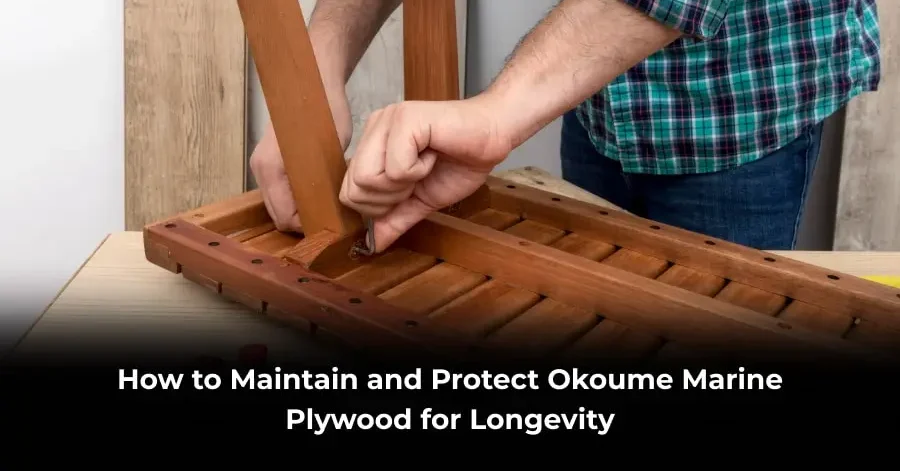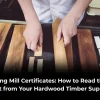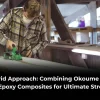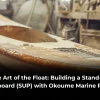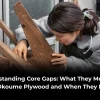There’s a special kind of magic in a boatbuilding project. The smell of fresh-cut timber, the feel of a smooth sanded surface, and the vision of a craft coming to life in your workshop. If you’ve chosen okoume marine plywood for your build, you’ve already made a fantastic decision. Renowned for its light weight, excellent strength-to-weight ratio, and beautiful finish, this plywood is a favorite among boatbuilders and fine furniture makers alike.
But here’s the secret every seasoned craftsman knows: the true beauty of okoume wood isn’t just in its initial workability; it’s in its potential for incredible longevity. Like a trusted tool or a cherished heirloom, your project deserves to stand the test of time. This isn’t just about slapping on a coat of varnish and calling it a day. It’s about understanding the material, respecting its vulnerabilities, and implementing a thoughtful protection strategy from the very start.
Whether you’re crafting a sleek kayak, a elegant piece of outdoor furniture, or intricate cabinetry, this guide will walk you through the essential steps to ensure your okoume plywood remains beautiful, strong, and functional for decades to come. We’ll cover everything from the initial preparation to long-term care, turning your project into a legacy piece.
Understanding Your Material: Why Okoume is Special (and Where it Needs Help)
First, let’s appreciate what we’re working with. Okoume marine plywood is not your average sheet of plywood. Sourced from the Okoume tree in Gabon, Africa, this okoume wood is prized for its large, smooth sheets and consistent, knot-free layers. The “marine” grade signifies it’s bonded with waterproof adhesives, making it highly resistant to delamination. This is crucial for withstanding the wet-dry cycles a boat or outdoor piece will endure.
However, the very thing that makes it so appealing—its relatively soft and porous nature—is also its Achilles’ heel. Unlike harder, denser woods, the surface of okoume plywood is susceptible to dings, scratches, and moisture penetration. The veneer can check (develop small cracks) if left unprotected under the sun, and prolonged water exposure can lead to rot. The goal of maintenance, therefore, is to create a durable, impermeable shield that protects the wood without compromising its natural elegance.
The Golden Rule: Start with a Flawless Foundation
The single most important step in protecting your okoume marine plywood happens before any sealant is even opened: surface preparation. A perfect finish cannot hide a flawed surface. In fact, it will magnify every imperfection.
- Sanding is Sacred: Begin with a progressive sanding schedule. Start with a coarser grit (like 80 or 100) to level any glue lines or minor imperfections, then move sequentially to 120, 150, and finally 180 or 220 grit. Always sand with the grain of the outer veneer to avoid cross-grain scratches. This meticulous process will result in a surface as smooth as silk, ready to accept a finish.
- The Clean Slate: After sanding, the surface is covered in microscopic dust. Use a tack cloth or a rag lightly dampened with mineral spirits to wipe down every square inch. Compressed air can also be effective for blowing dust out of crevices. Your surface should be clinically clean before proceeding.
Choosing Your Armor: A Guide to Finishes for Okoume Plywood
This is where you decide the final look and level of protection. Your choice will depend on the project’s intended use and your desired aesthetic. For the best selection of quality products, a specialized woodworking supplies store will be your best friend, offering expert advice and premium materials.
- Epoxy Encapsulation: The Ultimate Shield
For projects that will live in harsh environments, especially boats, epoxy is the gold standard. It doesn’t just sit on the surface; it penetrates deeply and creates a tough, waterproof barrier. The process typically involves:- Sealing: A thin, initial coat of epoxy is brushed on to seal the wood.
- Fabric (Optional): For added impact and crack resistance, a layer of fiberglass cloth can be applied while the epoxy is still tacky.
- Filling and Fairing: Subsequent coats are applied to fill the weave of the cloth and build a smooth surface.
- Topcoat: Epoxy is vulnerable to UV degradation, so it must be protected with a marine-grade varnish or paint.
- Marine Spar Varnish: The Classic Beauty
If you want to highlight the warm, honey-toned beauty of the okoume wood, a high-quality spar varnish is a great choice. Modern varnishes contain UV inhibitors to protect against sun damage and remain flexible to expand and contract with the wood. Applying 5-8 thin coats, sanding lightly between each, will build a deep, lustrous, and highly protective film. - Marine Paint: Opaque and Durable
For maximum color options and superior UV and abrasion resistance, paint is unbeatable. It completely blocks harmful sunlight and provides a hard, durable shell. Use a marine-grade primer specifically formulated for okoume plywood before applying the topcoat paint. This is an excellent choice for hulls and areas subject to heavy wear. - Hardening Oils: A Natural Feel
For interior projects or items that won’t see constant soaking, oils like tung oil or Danish oil can be appealing. They enhance the grain and offer a more natural, satin feel. However, they offer less protection against water and physical abuse and require more frequent reapplication.
The Art of Application: Patience is a Virtue
No matter what finish you choose, the application principles remain the same:
- Environment is Key: Apply finishes in a clean, dry, dust-free, and well-ventilated space. Ideal temperature is usually between 65-75°F (18-24°C).
- Thin Coats Win the Race: Multiple thin coats are infinitely better than one or two thick, gloppy coats. Thin coats dry harder, are less likely to run, and won’t trap solvents.
- Sand Between Coats: A very light sanding with 320-grit sandpaper between coats (after the previous coat has fully cured) creates a mechanical bond for the next layer, ensuring a strong, integrated finish. Remember to clean off the dust completely afterward.
Long-Term Care and Maintenance: The Relationship Continues
Your project is finished and in use. The maintenance now shifts from construction to care. Think of it as an ongoing relationship.
- Regular Cleaning: For boats and outdoor furniture, a simple rinse with fresh water after use removes salt, dirt, and pollutants that can degrade the finish over time.
- Annual Inspections: Once a year, give your project a thorough look-over. Check for any nicks, scratches, or hazy spots in the finish where UV damage might be starting.
- The Touch-Up: Don’t wait for a small scratch to become a big problem. Lightly sand the affected area, feathering the edges, and apply a fresh coat of your finish. A well-stocked woodworking supplies store will have small touch-up kits perfect for this job.
- Re-coating: Even the best varnish will eventually need refreshing. If the finish is still sound but just looks tired, a light sanding and one or two new coats can make it look brand new.
Also Read: Okoume Plywood vs. Other Plywood Types: Which One Should You Choose?
Sourcing Quality Materials: Start with the Best
The entire process outlined above begins with one critical decision: using high-quality materials from the start. Inferior okoume plywood or off-brand finishing products can undermine all your hard work. This is why it’s crucial to source your materials from a reputable supplier known for quality and expertise.
For those who demand the best, AEW Woods stands as a premier destination. With a longstanding reputation for excellence, AEW Woods specializes in providing top-grade okoume marine plywood and other premium marine lumber. Their commitment to quality ensures that the okoume plywood you receive is consistently superior, with flawless veneers and fully waterproof bonding. Partnering with a trusted supplier like AEW Woods means your project has the strongest possible foundation for a long and beautiful life.
Conclusion
Working with okoume marine plywood is a rewarding experience that blends traditional craftsmanship with modern materials. Its light weight and beautiful grain make it a joy to work with, but its long-term beauty is a direct result of the care and attention you invest in its protection. By understanding the nature of okoume wood, meticulously preparing the surface, choosing the right armor of epoxy, varnish, or paint, and committing to a simple regimen of long-term care, you are not just building a project.
You are stewarding a piece of craftsmanship. You are ensuring that the boat glides smoothly through the water for years, that the outdoor table hosts countless family gatherings, and that the cabinet becomes a cherished heirloom. So take your time, follow these steps, and take pride in knowing that your work with okoume marine plywood is built to last.
Frequently Asked Questions (FAQs)
- Is okoume marine plywood actually waterproof?
While the wood itself is not waterproof, the phenolic adhesive used in high-quality okoume marine plywood is 100% waterproof, preventing the layers from delaminating when wet. However, the wood veneers will still absorb water and can rot if not properly sealed and protected with a finish like epoxy or varnish. - Can I use regular varnish from a hardware store on my okoume plywood boat?
It is not recommended. Marine-grade varnishes contain higher levels of UV inhibitors and remain more flexible to handle the expansion and contraction of wood in a marine environment. Products from a dedicated woodworking supplies store or marine chandlery are formulated for this specific purpose. - How long will a finish last on okoume wood outdoors?
This depends heavily on the finish and exposure. A 6-8 coat epoxy/varnish system on a boat might last 2-5 years before needing a recoat, while a piece of garden furniture might go 1-3 years. Annual inspection is key to knowing when it’s time. - Why does my finished okoume plywood have a rough texture after the first coat?
This is called “grain raise.” The water or solvents in the finish cause the wood fibers to swell and stand up. It’s perfectly normal with okoume plywood. Simply let the coat dry completely, lightly sand it smooth with 220-grit paper, clean it, and apply your next coat. - I have a scratch down to the bare wood. How do I fix it?
Address it immediately to prevent moisture ingress. Carefully feather the edges of the scratch with fine sandpaper, clean the area, and apply a seal coat of your original finish (epoxy or varnish). You may need to build up several thin coats to level it with the surrounding area.

